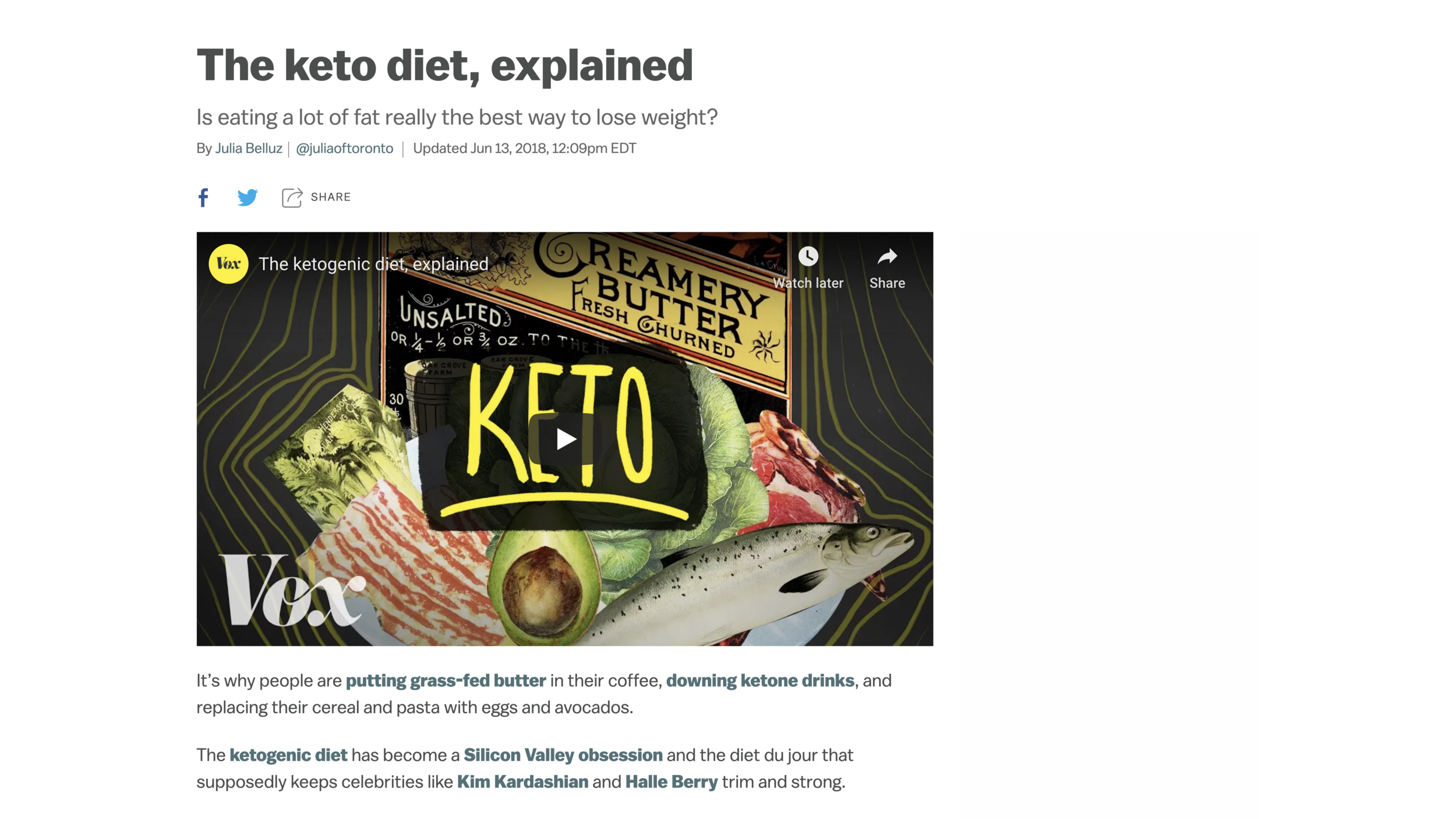On the Keto Diet
There is a lot of hype over diets. But when you eat is much more important for weight loss—and in many dimensions for health—than what you eat. In my view, the typical keto diet is a bit heavy on animal protein, but in its exclusion of sugar, bread, rice, potatoes and most other high-insulin-index foods, and its emphasis on non-starchy vegetables, it is reasonably close to what I eat. But the following graphic from Julia Belluz’s June 13, 2018 Vox article “The keto diet, explained” illustrates why many people don’t lose much weight on a keto diet: the “Low-carb diet” on the left has someone eating three meals a day plus snacks!
To a reasonable approximation, being in ketosis—fat-burning mode—is what it takes to make calories in/calories useful rather than misleading. (See “How Low Insulin Opens a Way to Escape Dieting Hell.”) But if you are eating three meals a day plus snacks, the difference between losing weight and gaining weight can be a subtle difference in how much you eat that might be hard to notice in practice—or so the evidence about how people do on the diet over the course of a year or more suggests. (Suppose, for example, that eating keto caused you to burn 100 calories more a day. You don’t have to eat much extra to counteract that effect.) By contrast, during periods of eating nothing (or almost nothing), you know what your calorie intake is. And a long enough fast (drinking water and maybe unsweetened tea or coffee, but not eating food) always puts you in ketosis.
I have no confidence that I would meet weight-loss goals if I were eating three meals a day plus snacks in a keto way. In what I eat, my low-insulin-index approach (see “Forget Calorie Counting; It's the Insulin Index, Stupid”) is reasonably close to keto. But I see the biggest benefit of eating that way that it makes it relatively painless to fast—whether for about 20 hours between a 4-hour eating window on two successive days or for a longer period of time. If my weight creeps up, as it often does, all I have to do is add in a few longer fasts.
The idea that keto helps reduce appetite is totally consistent with what I am saying: if you eat low on the insulin index, you can eat less and you won’t suffer. But no matter what you are eating, it tends to be relatively easy to slip in some extra calories. So to get real mileage out of a keto/low-insulin-index diet you really have to take advantage of the fact that eating that way makes it relatively painless to shift to eating nothing or very little for a time. If you don’t take advantage of that opportunity to eat nothing or very little without suffering, then the magic from a keto/low-insulin-index diet is likely to be of quite modest power.
In addition to working well with fasting, eating lowcarb can help with diabetes. I find this comment by Stephen Guyenet quoted in “The keto diet, explained” likely to be misleading to people looking for practical advice (though it might have some merit inside a technical debate relatively far afield from practical advice):
“What’s been demonstrated is that [the ketogenic diet] controls blood glucose levels,” explained Guyenet. “That’s a good thing. But to show true remission or reversal, you have to show a person can go back to being able to eat carbs without having diabetes again.” And that has never been proven with the ketogenic diet.
To translate: if you have diabetes, a lowcarb diet will help if you keep doing it. But doing a lowcarb diet for a short time and then returning to eating the way you were will pretty quickly put you back in the same trouble you were in. This is the nature of most good practices: you have to keep doing them to keep getting the benefits. (For weight loss I said similarly in “Kevin D. Hall and Juen Guo: Why it is So Hard to Lose Weight and So Hard to Keep it Off” that “permanent weight loss requires permanent changes in behavior.”)
In this post, I have been blurring over some of the distinctions between keto and low-insulin-index eating. To see some of the differences, take a look at my post “The Keto Food Pyramid.” But either can be combined with fasting reasonably well. Fasting—periods of time with no food are almost no food (but plenty of water)—is the key.
I also talk about the strategy of just adding more long fasts when weight creeps up in my post “Maintaining Weight Loss.”
For annotated links to other posts on diet and health, see:

